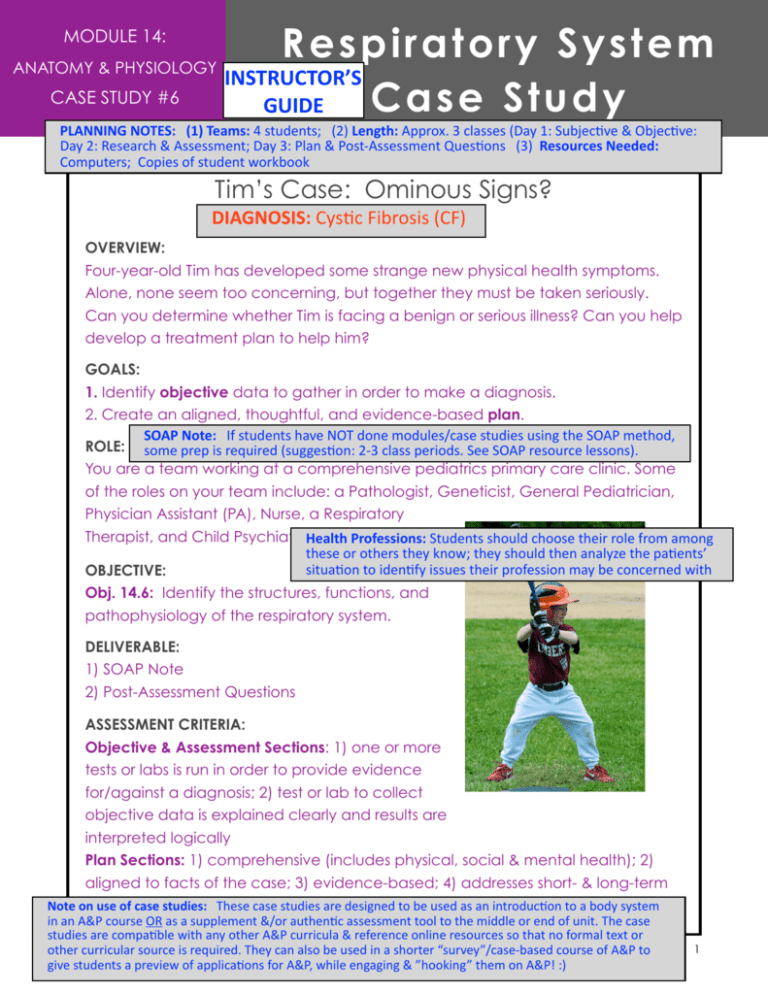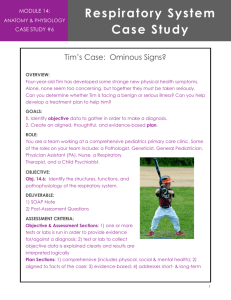14.6 - Instructor Guide (Respiratory)
advertisement

MODULE 14: ANATOMY & PHYSIOLOGY CASE STUDY #6 Respiratory System INSTRUCTOR’S Case Study GUIDE PLANNING NOTES: (1) Teams: 4 students; (2) Length: Approx. 3 classes (Day 1: Subjec>ve & Objec>ve: Day 2: Research & Assessment; Day 3: Plan & Post-­‐Assessment Ques>ons (3) Resources Needed: Computers; Copies of student workbook Tim’s Case: Ominous Signs? DIAGNOSIS: Cys$c Fibrosis (CF) OVERVIEW: Four-year-old Tim has developed some strange new physical health symptoms. Alone, none seem too concerning, but together they must be taken seriously. Can you determine whether Tim is facing a benign or serious illness? Can you help develop a treatment plan to help him? GOALS: 1. Identify objective data to gather in order to make a diagnosis. 2. Create an aligned, thoughtful, and evidence-based plan. SOAP Note: If students have NOT done modules/case studies using the SOAP method, ROLE: some prep is required (sugges>on: 2-­‐3 class periods. See SOAP resource lessons). You are a team working at a comprehensive pediatrics primary care clinic. Some of the roles on your team include: a Pathologist, Geneticist, General Pediatrician, Physician Assistant (PA), Nurse, a Respiratory Therapist, and Child Psychiatrist. Health Professions: Students should choose their role from among these or others they know; they should then analyze the pa>ents’ situa>on to iden>fy issues their profession may be concerned with OBJECTIVE: Obj. 14.6: Identify the structures, functions, and pathophysiology of the respiratory system. DELIVERABLE: 1) SOAP Note 2) Post-Assessment Questions ASSESSMENT CRITERIA: Objective & Assessment Sections: 1) one or more tests or labs is run in order to provide evidence for/against a diagnosis; 2) test or lab to collect objective data is explained clearly and results are interpreted logically Plan Sections: 1) comprehensive (includes physical, social & mental health); 2) aligned to facts of the case; 3) evidence-based; 4) addresses short- & long-term Note on use of case studies: These case studies are designed to be used as an introduc>on to a body system in an A&P course OR as a supplement &/or authen>c assessment tool to the middle or end of unit. The case studies are compa>ble with any other A&P curricula & reference online resources so that no formal text or other curricular source is required. They can also be used in a shorter “survey”/case-­‐based course of A&P to give students a preview of applica>ons for A&P, while engaging & ”hooking” them on A&P! :) 1 MODULE UNIT 1: MENTAL 14: ANATOMY HEALTH & PHYSIOLOGY Case Study Steps: CASE STUDY #6: RESPIRATORY LESSON SYSTEM 1.1 Steps: This checklist will help orient students, encourage them to manage their >me and tasks, and help them process the flow of the case. _____ 1. Review the coversheet information. Assign team roles. _____ 2.. Read the case information and fill out the SOAP note. _____ 3. Research possible conditions or diseases. _____ 4. Determine one or more lab/tests to gather objective data. _____ 5. Complete the Assessment and Plan for the patient. _____ 6. Complete the Post-Assessment Questions. 2 MODULE UNIT 1: MENTAL 14: ANATOMY HEALTH & PHYSIOLOGY CASE STUDY #6: RESPIRATORY LESSON SYSTEM 1.1 Health Care Provider Roles: Determine the role of each team member. Then work together to determine what focus area you will be in charge of in Tim’s case. Team Member Role Specific Focus Areas Roles: Remind students to return to the cover sheet “roles” sec>on to iden>fy possible roles. For “specific focus areas”, provide a few examples. e.g., #1: child psychiatrist may be concerned with pa>ent’s (and parents) mental health a\er receiving diagnosis e.g., #2: respiratory therapist might be concerned with the specific breathing/airway issues and that por>on of the treatment plan 3 MODULE 14: ANATOMY & PHYSIOLOGY Case Information: CASE STUDY #6: RESPIRATORY SYSTEM THOROUGHNESS: Remind students to be thorough when documen>ng the details in the SOAP note. Even if a detail seems irrelevant, it may be important later. Simultaneously, encourage them to be succinct & concise in their notes. Jane brings in her four-year-old named Tim to a comprehensive pediatrics clinic in order to assess his health status. Jane reports that Tim is very curious and smart and gets along socially with other children. Jane says that Tim’s preschool teacher suggested she take him into the doctor for a health screening, because she has noticed his stools looking oily when he uses the bathroom. Patient History: Tim’s mother Jane is a former drug user and has no family in the area. For these reasons, along with the socioeconomic status of his household (below the poverty line), Tim had a difficult first few years of life. However, recently his mom got help from social services and has been drug-free for six months. They are living in a new rental home and Tim is adjusting well to his new living situation, but is still struggling at school. He recently had several accidents and so they temporarily put him in pull-up diapers. He has also shown to be hesitant in engaging in physical activity and seems more tired and exhausted than a typical four-year-old should be. Measurements & Vital Signs Age: 4.5 yrs Height: 3 ft. 7 inch Weight: 32 lbs. Pulse: 108 bpm Respiratory Rate: 30 breaths/min Temperature: 99.1 degrees F Blood pressure: 100/55 mmHg Physical Exam: General appearance: Good-natured, active, secure Ear, Nose & Throat: Runny nose. Ears do not show sign of infection Abdominal: Normal; no pain reported upon touching Neuro: Normal Respiratory: Cracking/wheezing sounds; slight cough Cardio: Normal Nails: Nails normal in color but nail beds are slightly curved 4 MODULE 14: ANATOMY & PHYSIOLOGY CASE STUDY #6: RESPIRATORY SYSTEM All details from previous page should be documented! 5 UNIT 1: MENTAL MODULE 14: ANATOMY HEALTH & PHYSIOLOGY CASE CASE STUDY STUDY #6: #1: RESPIRATORY TOBY’S TROUBLES SYSTEM Research: Team Member Possible Diseases Notes RESEARCH: Have students complete this before wri>ng the assessment & final plan. Before students decide what they will focus on for research, remind them to think about their interest/areas of exper>se as well as the key issues in Tim’s case. Once research is complete have them return to teams and share informa>on, no>ng the key points from one another’s reports. Remind them to ask ques>ons and write any follow-­‐up ques>ons or points of confusion or clarifica>on they need to look up prior to deciding on the diagnosis & plan. 6 MODULE 14: ANATOMY & PHYSIOLOGY CASE STUDY #6: RESPIRATORY SYSTEM CysMc Fibrosis -­‐-­‐Sweat chloride test, spirometry test, chest x-­‐ray, arterial blood gas check, & secre>n s>mulator test -­‐-­‐consistency of stools (oily, greasy) -­‐-­‐Runny nose, cracking/wheezy breathing sounds, cough -­‐-­‐Curved nail beds CysMc Fibrosis Treatment OpMons: -­‐-­‐Changes to diet (increasing calories) -­‐-­‐An>-­‐inflammatory -­‐-­‐Medica>ons: bronchodilators, mucoly>c agents, an>bio>cs, pancrea>c enzyme replacement -­‐-­‐Airway clearance therapy -­‐-­‐Eventually, the possibility of lung transplanta>on 7 PURPOSE: These ques>ons will help learners connect the case study pa>ent scenario with the structure, func>on & pathophysiology of the skin system. MODULE 14: ANATOMY & PHYSIOLOGY CASE STUDY #6: RESPIRATORY SYSTEM USE OF THESE QUESTIONS: The amount of >me students need to research answers to these ques>ons will depend on the concurrent or previous level of instruc>on/pre-­‐reading about the skin system. Post-Assessment Questions: 1. What does a spirometer measure? How does it work? Who would it be used on? A spirometer is an instrument for measuring the air capacity of the lungs. Source for more info: Mayo Clinic: hap://www.mayoclinic.org/tests-­‐procedures/spirometry/basics/defini>on/prc-­‐20012673 Cleveland Clinic: hap://my.clevelandclinic.org/services/surgery/hic_how_to_use_an_incen>ve_spirometer.aspx 2. Explain the diagram on the right. What does each component represent? Source sugges>on: hap://en.wikipedia.org/wiki/Lung_volumes When you look at this diagram think, as the line goes up (and >me goes on, across the x-­‐axis) a person is breathing IN, and when the line is going down they are breathing OUT. Try it. Breath in, line up. Breath out, line down. Think of IRV as a “BIG breath IN” (the most you could possibly breath in) and ERV as a big breath out (the most you could exhale). Try it again… Look up what the abbrevia>ons mean on p. 448 and it should be easy to remember which is which when you see them E=Expira>on; I=Inspira>on. When you see the TV, think of a Tide in the Ocean…it goes in and out back and forth, this is normal breathing (Tidal Volume). Think of Vital Capacity as the total amount of air that can be exchanged. DEAD space is unusable air, (in the trachea, bronchi, etc.) that never touches the alveoli! Residual volume (RV) is the amount of space le\ in the lungs that can never be forced out (or your lungs would collapse!). There is always a >ny bit of air in them. 3. What are the main functions of the respiratory system? Which are currently or may be in the future compromised in Tim? A) Supplies body with O2 and disposes of CO2 (i.e., respira>on and ven>la>on). B) Houses olfactory (smell) receptors. C) Provides sound and speech making organs and >ssues. 4. Describe normal developmental changes in the respiratory system? Source Images for >meline of childhood lung/respiratory development: hap://www.environment.ucla.edu/reportcard/ar>cle1700.html Changes in aging: hap://www.nlm.nih.gov/medlineplus/ency/ar>cle/004011.htm 5. Name & describe a few of the most common respiratory illnesses to affected children and teenagers. Source sugges>ons: AANMA: hap://www.aanma.org/faqs/welcome-­‐to-­‐precious-­‐breathers/respiratory-­‐ diseases/ Cleveland Clinic: hap://my.clevelandclinic.org/healthy_living/childrens_health/ hic_childhood_respiratory_infec>ons_and_other_illnesses.aspx 8





